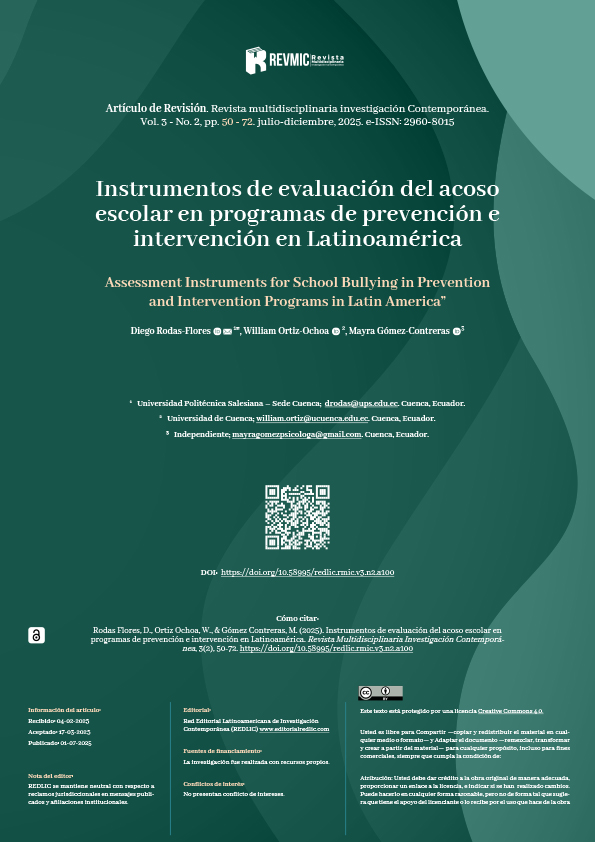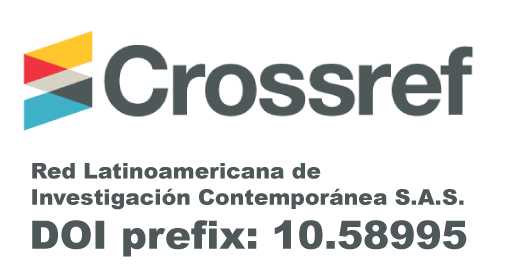Bullying assessment tools in prevention and intervention programs in Latin America
Abstract
Bullying and cyberbullying are challenging issues for health systems worldwide; assessment constitutes a necessary mechanism to establish diagnoses and guide interventions. The objective of this study was to identify the assessment tools used in prevention or intervention programs addressing bullying and cyberbullying implemented in Latin America with primary and secondary school students. A search was conducted for articles (in Spanish and English) published over the last 20 years (2004–2024) in the PubMed, Web of Science, Scielo, and Scopus databases. Twelve articles were included, highlighting that the instruments applied evaluate dimensions such as victimization, perpetration, justification of bullying, and prosocial behavior, as well as the roles in which students are involved. The discussion addresses the reliability and validity of the instruments, and it suggests the development and validation of robust and culturally sensitive tools.
Downloads
References
- Álvarez-García, D., Núñez, J., y Dobarro, A. (2013). Cuestionario para evaluar la violencia escolar en educación secundaria: CUVE3-EP y CUVE3-ESO. Apuntes de Psicología, 31(2), 191–202. https://www.apuntesdepsicologia.es/index.php/revista/article/view/322 DOI: https://doi.org/10.55414/ap.v31i2.322
- Avilés-Martínez, J. (2013). Herramientas para la evaluación del bullying. Estudos em Avaliação Educacional, 24(56), 138-167. https://doi.org/10.18222/eae245620132737 DOI: https://doi.org/10.18222/eae245620132737
- Bottan, G., Vizini, S., Oliveira, P., Pinto, L., Peixoto, B., Rigatti, R., y Heldt, E. (2020). Brief antibullying intervention adolescents in public schools. Revista Gaúcha de Enfermagem, 41. e20190336. https://doi.org/10.1590/1983-1447.2020.20190336 DOI: https://doi.org/10.1590/1983-1447.2020.20190336
- Cajigas, N., Kahan, E., Luzardo, M., Najson, S., Ugo, C., y Zamalvide, G. (2006). Agresión entre pares (bullying) en un centro educativo de Montevideo:estudio de frecuencias de los estudiantes de mayor riesgo. Revista Médica Uruguaya, 22(2), 143-151. https://revista.rmu.org.uy/index.php/rmu/article/view/774
- Cedillo-Ramírez, L. (2020). Acoso escolar cibernético en el contexto de la pandemia por COVID-19. Revista Chilena de Pediatría, 4(59), 1–3. https://doi.org/10.32641/rchped.v91i3.1230 DOI: https://doi.org/10.32641/rchped.v91i3.1230
- Dennehy, R., Meaney, S., Walsh, K. A., Sinnott, C., Cronin, M., y Arensman, E. (2020). Young people’s conceptualizations of the nature of cyberbullying: A systematic review and synthesis of qualitative research. Aggression and Violent Behavior, 51, 101379. https://doi.org/10.1016/J.AVB.2020.101379 DOI: https://doi.org/10.1016/j.avb.2020.101379
- Fernandes, G., y Dell’Aglio, D. D. (2023). Evaluation of an anti-bullying intervention in the school context. Estudos de Psicologia (Campinas), 40, e210096. https://doi.org/10.1590/1982-0275202340e210096 DOI: https://doi.org/10.1590/1982-0275202340e210096
- Ferreira-Junioe, V., Coutinbo-Lourenco, F., Menezes, A., Dell Gusmoes, J., Cogo-Moreira, H., y Sanchez, Z. (2022).Psychometric validation of the audio-guided rBVQ instrument for bullying evaluation among students. Psico-USF, 27(2), 387-392. https://doi.org/10.1590/1413-82712022270214 DOI: https://doi.org/10.1590/1413-82712022270214
- Gámez-Guadix, M., Villa-George, F. y Calvete E. (2014). Psychometric Properties of the Cyberbullying Questionnaire (CBQ) Among Mexican Adolescents. Violence and Victims, 29(2), 232-247. http://connection.ebscohost.com/c/articles/95534592/psychometric-propertiescyberbullying-questionnaire-cbq-among-mexican-adolescents DOI: https://doi.org/10.1891/0886-6708.VV-D-12-00163R1
- Gómez Tabares, A.S. y Correa Duque, M.C. (2022). La asociación entre acoso y ciberacoso escolar y el efecto predictor de la desconexión moral: una revisión bibliométrica basada en la teoría de grafos. Educación XX1, 25(1), 273-308. https://doi.org/10.5944/educXX1.29995 DOI: https://doi.org/10.5944/educxx1.29995
- Gusmões, J., Sañudo, A., Valente, J., y Sanchez, Z. (2018). Violence in Brazilian schools: Analysis of the effect of the #Tamojunto prevention program for bullying and physical violence. Journal of Adolescence, 63(2018), 107-117. https://doi.org/10.1016/j.adolescence.2017.12.003 DOI: https://doi.org/10.1016/j.adolescence.2017.12.003
- Gutiérrez-Ángel, N. (2019, 15 de noviembre - 15 de diciembre). Revisión de los instrumentos de evaluación del bullying y del cyberbullying empleados en los últimos siete años [Comunicación aceptada]. Congreso Iberoamericano: La educación ante el nuevo entorno digital, España. https://formacionib.org/congreso-entorno-digital/0010.pdf
- Herrera-López, M., Romera, E., y Ortega-Ruiz, R. (2018). Bullying y Ciberbullying en Latinoamérica. Un estudio bibliométrico. Revista Mexicana de Investigación Educativa, 23(76), 125-155. https://www.redalyc.org/articulo.oa?id=14054854006
- Hormazábal-Aguayo, I., Fernández-Vergara, O., González-Calderón, N., Vicencio-Rojas, F., Russell-Guzmán, J., Chacana-Cañas, C., Pozo-Cruz, B., y García-Hermoso, A. (2019). Can a before-school physical activity program decrease bullying victimization in disadvantaged children? The Active-Start Study. International Journal of Clinical and Health Psychology, 19(2019), 237-242. https://doi.org/10.1016/j.ijchp.2019.05.001 DOI: https://doi.org/10.1016/j.ijchp.2019.05.001
- Lecannelier, F., Varela, J., Rodriguez, J., Hoffmann, M., Flores, F., y Ascanio, L. (2011). Validación del cuestionario de secundaria de maltrato entre iguales por abuso de poder (MIAP) para escolareas de la ciudad de Concepción. Revista Médica Chile, 139, 474-479. https://www.scielo.cl/scielo.php?script=sci_arttext&pid=S0034-98872011000400009 DOI: https://doi.org/10.4067/S0034-98872011000400009
- Lucas-Molina, B., Pérez-Albeniz, A., y Giménez-Dasí, M. (2016). La evaluación del Cyberbullying: Situación actual y retos futuros. Papeles del Psicólogo, 37(1), 27-35. https://www.redalyc.org/journal/778/77844204004/html/
- Martínez-Vilchis, V., Morales, T., y Pozas, J. (2018). Efectos de un programa de competencias emocionales en la prevención de cyberbullying en bachillerato. Revista Pensamiento Psicológico, 16(1), 1-17. https://doi.org/10.11144/Javerianacali.PPSI16-1.epce DOI: https://doi.org/10.11144/Javerianacali.PPSI16-1.epce
- Ministerio de Educación del Perú. (2013). Análisis psicométrico del Piloto de Cuestionario de Bienestar Escolar de Primaria y Secundaria- Estudio 2013. Lima: MINEDU.
- Olweus, D. (1998). Conductas de acoso y amenaza entre escolares. Ediciones Morata. https://books.google.es/books?hl=esylr=yid=S0wSk71uQz0Cyoi=fndypg=PA10ydq=acoso+escolar+Olweusyots=7CLQezIyd8ysig=QV7FVwQpvwolJsgHX-WFctNPfzk#v=onepageyqyf=false
- Olweus, D. (2007). Acoso escolar: hechos y medidas de intervención. Publicaciones Del Research Centre for Health Promotion. https://d1wqtxts1xzle7.cloudfront.net/38159104/acoso_escolar__hechos_y_medidas_para_su_prevencion-libre.pdf?1436628058=yresponse-content-disposition=inline%3B+filename%3DACOSO_ESCOLAR_HECHOS_Y_MEDIDAS_DE_INTERV.pdfyExpires=1731542316ySignature=VdGPmZdy97b~PexAD-iCxHS5sa~yg2YWKSzAGTtJg1-U-ewGplkpBLrq0m8ZL-OPf9eYMo4AZ8V1hOwkeG8AmrM8mMgB7oXREJ~qt1Rj10oveSYLaHjijZAkQXfiCTJXUw5gchiQkezOPxuaKnmPdNTtQBFJ6qzXDSOamYevGEnaOU36~7wINeVUPaha-Fq-s9KPyl7FrOaHBJ0ABYSTw7cnNRq1lo2WlT1la7qAIPTx0Y~cvHx6K1Zxsdm0XE0ZG24AWuGvlzXDO2fmcwIfevkkZZil1TFBApLmkhRioWo4ONWOeRnRFs1i9dZO0g0RmDy38pouIwP0a90kYi5WCw__yKey-Pair-Id=APKAJLOHF5GGSLRBV4ZA
- Ordóñez-Ordóñez, M.C. y Prado, K.D. (2019).Bullying y cyberbullying escolar en niños y jóvenes adolescentes: un estudio de caso. Revista MASKANA, 10(2), 32–41, https://publicaciones.ucuenca.edu.ec/ojs/index.php/maskana/article/view/2709doi:10.18537/mskn.10.02.04 DOI: https://doi.org/10.18537/mskn.10.02.04
- Ortega, R. (2020). La dimensión moral en las redes: Cyberbullying y la educación ética para la ciudadanía. Cuadernos de Pedagogía, 510, 70–75. https://dialnet.unirioja.es/servlet/articulo?codigo=7608568yinfo=resumenyidioma=ENG
- Palacios, D., Berger, C., Luengo, B., Veenstra, R., y Komelis, J. (2019). The Interplay of Adolescents` Aggression and Victimization with Friendship and Antipathy Networks within an Educational Prosocial Intervention. Journal of Youth and Adolescence, 48(2019), 2005-2022. https://doi.org/10.1007/s10964-019-01105-z DOI: https://doi.org/10.1007/s10964-019-01105-z
- Páez, A., Ramírez, M., Campos, A., Duarte, L., y Urreaga, E. (2020). Prevalencia y factores asociados con el acoso escolar en adolescentes. Revista Cuidarte, 3, 1-15. http://dx.doi.org/10.15649/cuidarte.1000 DOI: https://doi.org/10.15649/cuidarte.1000
- Pereira-Gallindo, L. (2014). Todo se convirtió en bullying… Importancia del diagnóstico diferencial para una mejor atención. Salud de los trabajadores, 22(1), 47-55. https://ve.scielo.org/pdf/st/v22n1/art06.pdf
- Pérez, J., Astudillo, J., Varela, J., y Lecannelier, F. (2013). Evaluación de la efectividad del Programa Vínculos para la prevención e intervención del Bullying en Santiago de Chile. Revista Semestral da Associação Brasileira de Psicologia Escolar e Educacional, 17(1), 163-172. https://doi.org/10.1590/S1413-85572013000100017 DOI: https://doi.org/10.1590/S1413-85572013000100017
- Pozas, J., Morales, T., y Martínez, R. (2018). Efectos de un programa de ciberconvivencia en la prevención del cyberbullying. Psychology, Society, y Education, 10(2). 239-250. https://doi.org/10.25115/psye.v10i1.1953 DOI: https://doi.org/10.25115/psye.v10i2.1953
- Santa-Cruz, H., y Ríos, J. (2022). Efectos del Programa CONVIVE sobre la percepción de violencia escolar en adolescentes. Eureka, 19(2), 217-233. https://ojs.psicoeureka.com.py/index.php/eureka/article/view/67
- Smith, P. K., Mahdavi, J., Carvalho, M., Fisher, S., Russell, S., y Tippett, N. (2008). Cyberbullying: its nature and impact in secondary school pupils. Journal of Child Psychology and Psychiatry, 49(4), 376–385. https://doi.org/10.1111/J.1469-7610.2007.01846.X DOI: https://doi.org/10.1111/j.1469-7610.2007.01846.x
- Smith, P. K., Sundaram, S., Sandhu, D., Blaya, C., Schäfer, M., & Spears, B. (2018). Introduction. In P. K. Smith, S. Sundaram, B. A. Spears, C. Blaya, M. Schäfer, y D. Sandhu (Eds.), Bullying, cyberbullying and student well-being in schools: comparing European, Australian and Indian perspectives. Cambridge University. https://doi.org/10.1017/9781316987384 DOI: https://doi.org/10.1017/9781316987384
- Stelko-Pereira, A. C., Williams, L. C. A., y Freitas, L. C. (2010). Validade e consistência interna do Questionáriode Investigação de Prevalência de Violência Escolar – versão estudantes [Validity and internal consistencyof the School Violence Prevalence investigation questionnaire – student version]. Avaliação Psicológica, 9(3), 403-411. https://pepsic.bvsalud.org/scielo.php?script=sci_arttext&pid=S1677-04712010000300007
- Stelko-Pereira, A. C., y de Albuquerque, L. C. (2016). Evaluation of Barzilian School Violence Prevention Program (Violência Nota Zero). Pensamiento Psicológico, 14(1), 63-76. https://www.redalyc.org/journal/801/80144041005/html/ DOI: https://doi.org/10.11144/Javerianacali.PPSI14-1.ebsv
- Stelko-Pereira, A. C., Williams, L. C. A., y Freitas, L. C. (2010). Validade e consistência interna do Questionáriode Investigação de Prevalência de Violência Escolar – versão estudantes [Validity and internal consistencyof the School Violence Prevalence investigation questionnaire – student version]. Avaliação Psicológica, 9(3), 403-411. https://pepsic.bvsalud.org/scielo.php?script=sci_arttext&pid=S1677-04712010000300007
- Tokunaga, R. S. (2010). Following you home from school: A critical review and synthesis of research on cyberbullying victimization. Computers in Human Behavior, 26(3), 277–287. https://doi.org/10.1016/J.CHB.2009.11.014 DOI: https://doi.org/10.1016/j.chb.2009.11.014
- Valente, J., de Oliveira, P., Mari, J., y Sanchez, Z. (2023). The Indirect Effect of #Tamojunto2.0 Program on Bullying Through Reduction of Alcohol Use Initiation. Journal of Adolescent Health, 73(2023), 118-128. https://doi.org/10.1016/j.jadohealth.2023.02.023 DOI: https://doi.org/10.1016/j.jadohealth.2023.02.023
- Vanega-Romero, S., Sosa-Correa, M., y Castillo-Ayuso, R. (2018). Acoso escolar, ira y depresión en adolescentes mexicanos: un estudio preliminar de la eficacia de una intervención. Revista de Psicología Clínica con Niños y Adolescentes, 5(2), 49-54. https://doi.org/10.21134/rpcna.2018.05.2.7 DOI: https://doi.org/10.21134/rpcna.2018.05.2.7
- Vera-Giraldo, C., Vélez, C., y García-García, H. (2017). Medición del bullying escolar: Inventario de instrumentos disponibles en idioma español. Revista Latinoamericana de Ciencia Psicológica, 9(1), 1–16. http://www.redalyc.org/articulo.oa?id=333152921004

Published 2025-03-25
Keywords
- bullying,
- evaluation,
- chilhood,
- adolescence
Issue
Section
Copyright (c) 2025 Los autores que publiquen en la revista Multidisciplinaria Investigación Contemporánea aceptan los siguientes términos: 1. Los autores mantienen sus derechos de autor (copyright) y otorgan a la revista Multidisciplinaria Investigación Contemporánea el derecho de la primera publicación de su trabajo, bajo una licencia Creative Commons Attribution 4.0. Esta licencia permite que terceros utilicen el contenido publicado, siempre que se mencione la autoría y la primera publicación en esta revista. 2. Los autores pueden establecer acuerdos adicionales para la distribución no exclusiva de la versión publicada de su artículo en otros lugares, como repositorios institucionales, siempre y cuando se indique claramente que el trabajo fue publicado por primera vez en esta revista. 3. Los autores conservan sus derechos de autor (copyright) y garantizan a la revista Multidisciplinaria Investigación Contemporánea el derecho a publicar el manuscrito a través de los canales que considere apropiados. 4. Se permite y se recomienda a los autores compartir su trabajo en línea (por ejemplo, en repositorios institucionales o páginas web personales), una vez que el manuscrito haya sido aceptado para su publicación. Esto puede conducir a intercambios productivos y a una mayor y más rápida citación del trabajo publicado.

This work is licensed under a Creative Commons Attribution 4.0 International License.



















